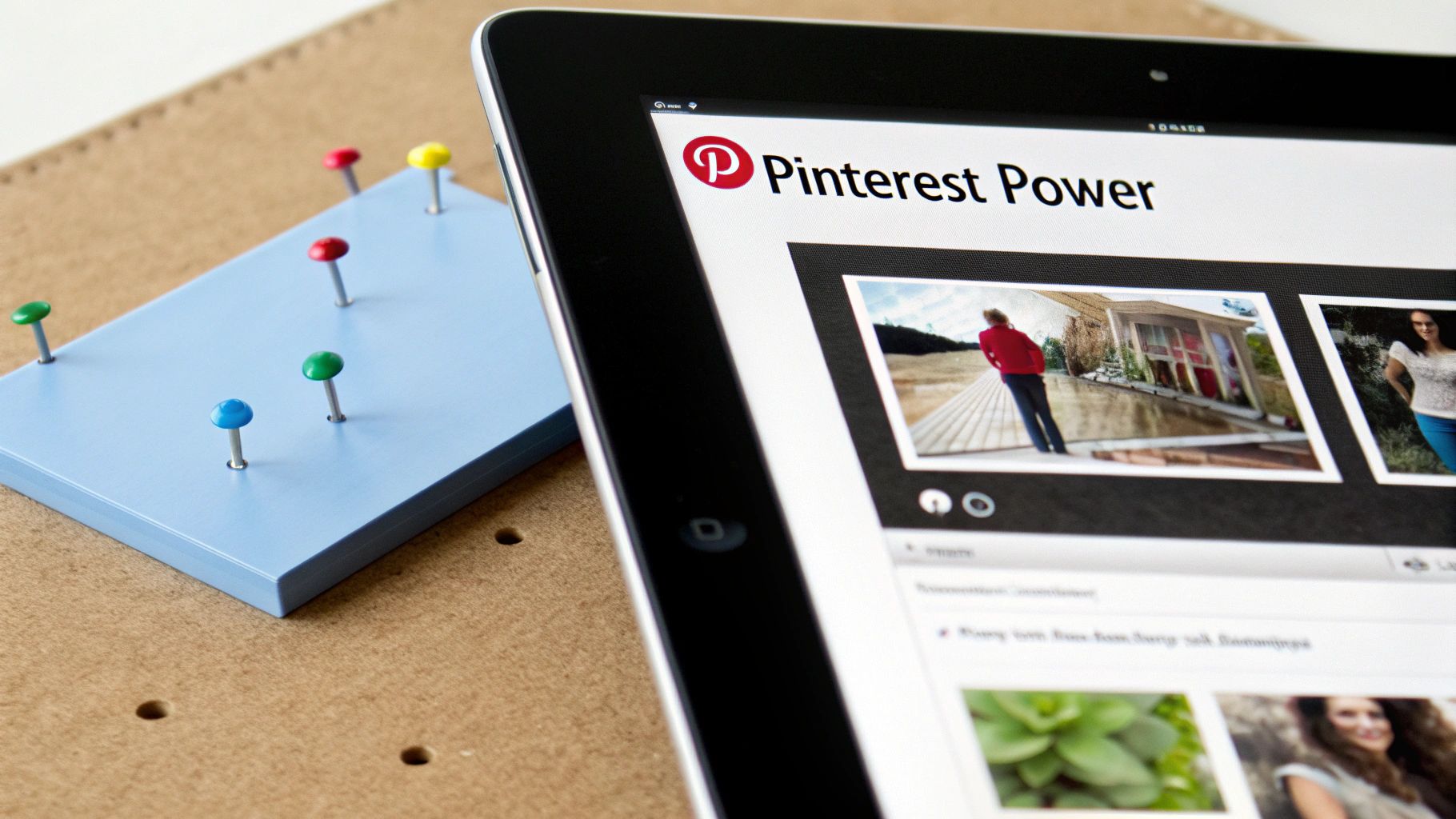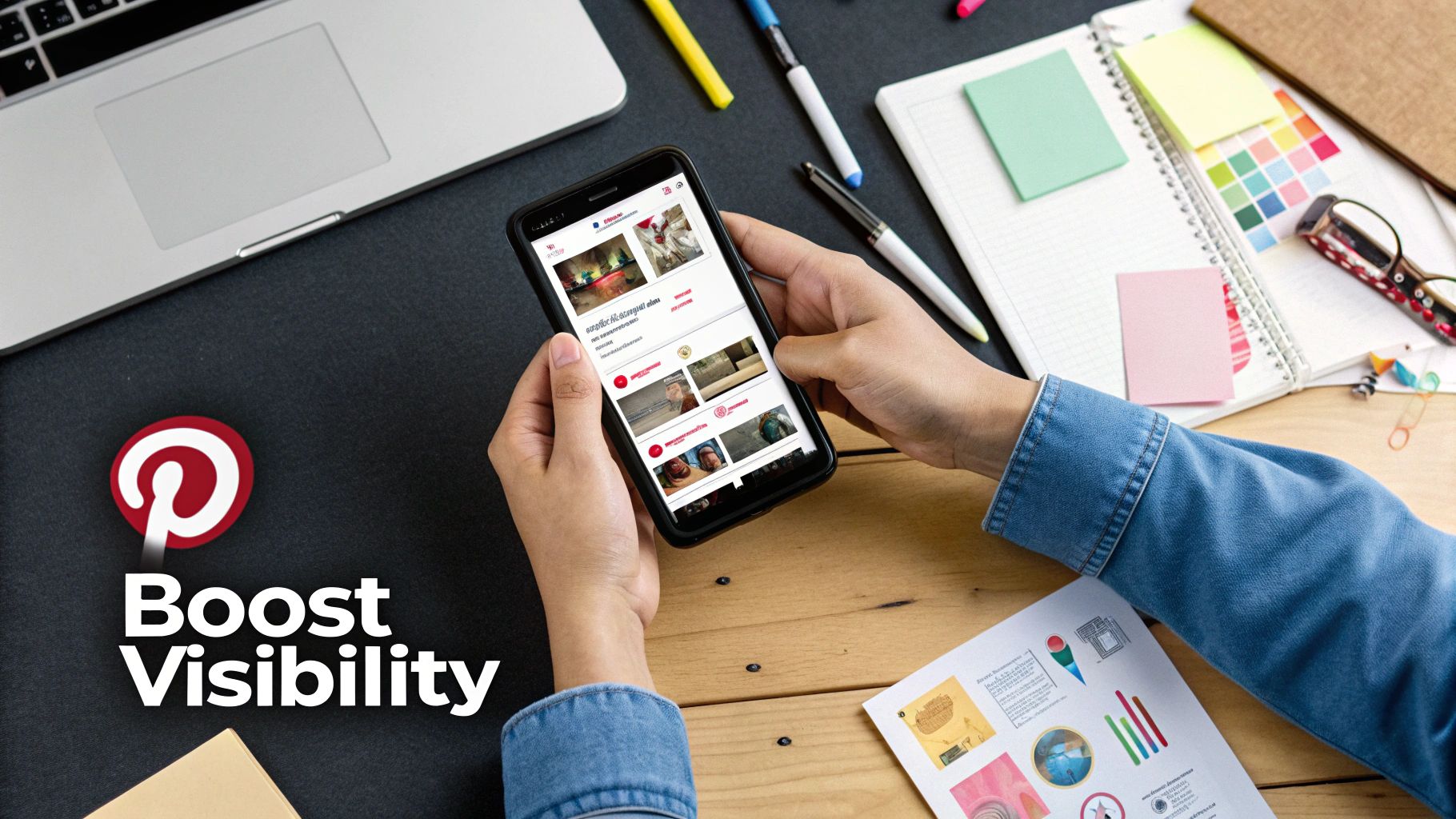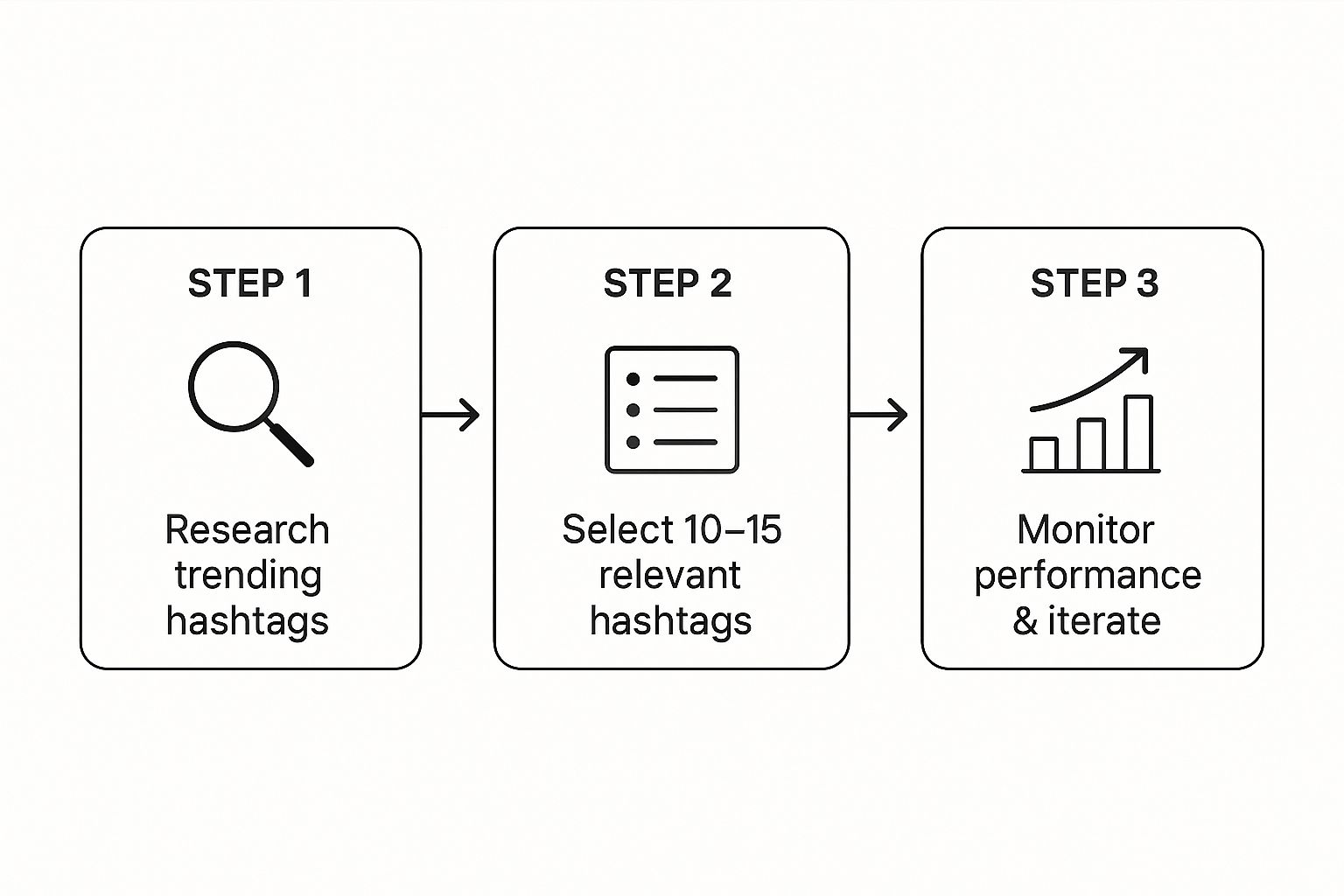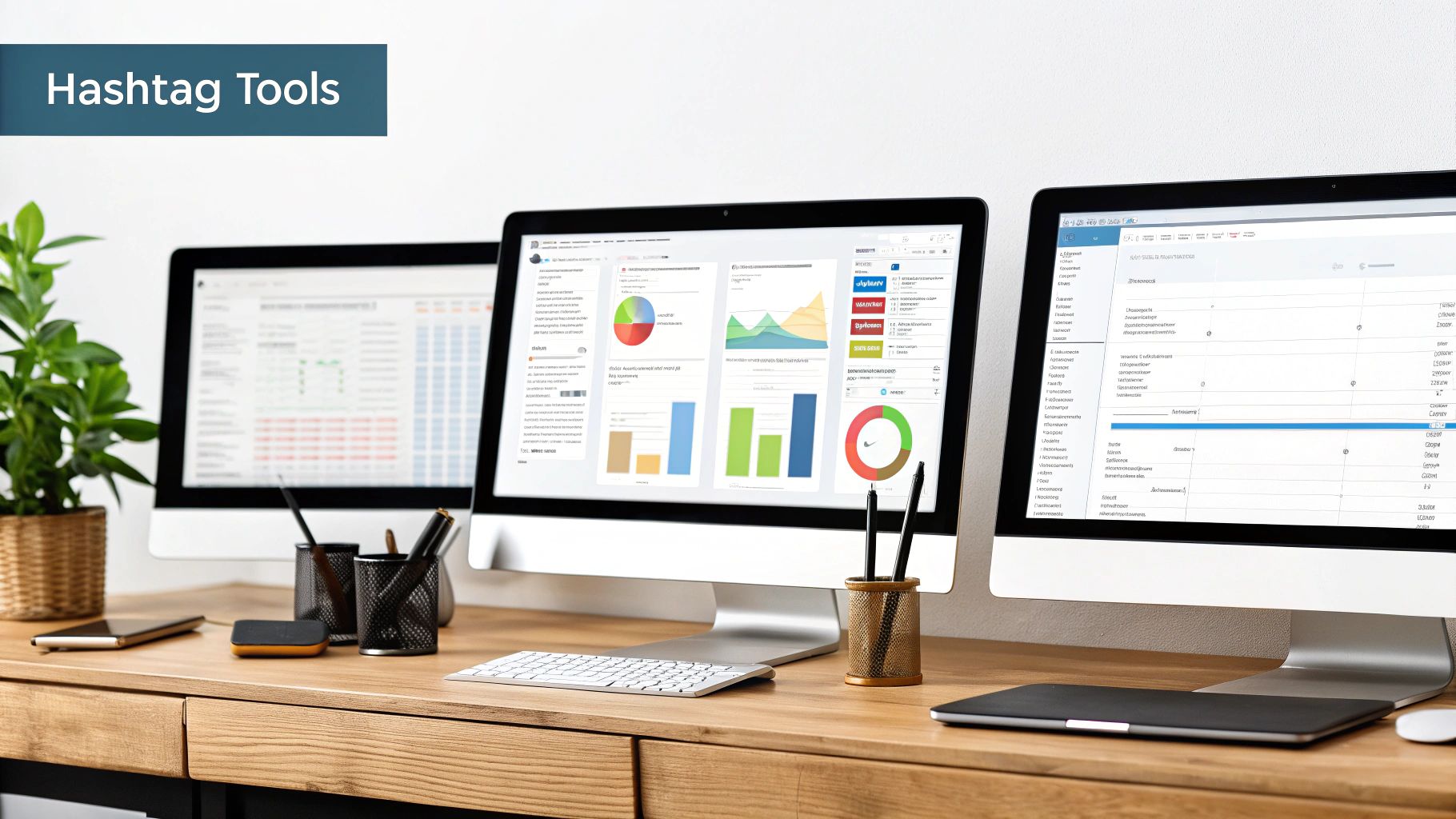Pinterest and Hashtags a Modern Guide
I've seen so much conflicting advice about Pinterest hashtags floating around, but let's set the record straight: they are absolutely crucial for getting your content discovered.
On other social platforms, hashtags often chase fleeting trends. Pinterest is different. Here, they act like powerful, targeted keywords, guiding people who are actively searching for ideas right to your Pins. A solid hashtag strategy isn't just a "nice-to-have" anymore; it's a fundamental piece of your Pinterest SEO puzzle.
Why You Can't Afford to Ignore Pinterest Hashtags

Let's clear the air. There was a period when the advice on using hashtags for Pinterest was, frankly, all over the place. Some "gurus" even claimed they were dead. Thankfully, Pinterest has since clarified their stance and refined how hashtags work, re-establishing them as a vital tool for anyone trying to grow on the platform.
The best way to think about them is less like Instagram's trend-driven tags and more like super-specific categories that sort content chronologically.
When someone searches for or clicks on a hashtag like #diyhomedecor, they're shown a feed of the newest Pins with that tag first. This is a huge advantage. It gives your fresh content an immediate shot at visibility, perfectly complementing the long-term discoverability you get from your keyword-optimized Pin descriptions.
Tap Into a Huge, Active Audience
The audience on Pinterest isn't just big; it's growing fast and ready to engage. As of early 2025, Pinterest reported a staggering 570 million global monthly active users—a 10% jump from the previous year. This growth is fueled by a younger audience, with Gen Z now making up over 42% of its user base.
What does this mean for you? It means there's a massive, discovery-minded audience waiting. Since most people are scrolling on their phones, your Pins need to be both visually compelling and easy to find through hashtags. If you want to dive deeper, you can explore more about these user trends and how they should shape your strategy.
A well-thought-out hashtag strategy connects your content directly to this audience. It ensures your Pins don't just get lost in the noise but become an active part of the discovery process. When you treat hashtags as a non-negotiable part of your pinning routine, you open up a direct line to the people looking for exactly what you have to offer.
Finding Hashtags People Actually Use
So, you're ready to stop throwing random hashtags at your Pins and hoping for the best? Good. Finding the right hashtags is what separates a Pin that gets seen from one that just fades away. Your best friend in this process is already built right into the platform: the Pinterest search bar. Seriously, it's a goldmine.
Let’s say you’re posting about a home office setup. Start by typing a broad keyword like "home office" into the search bar, but don't press enter just yet. Watch as Pinterest’s auto-suggest kicks in, showing you what real people are actually looking for. You’ll probably see things like “home office ideas,” “home office design,” and “small home office.” These aren't just search terms; they're your first batch of potential hashtags.
Now, just pop a hash symbol (#) in front of those suggested terms. It’s that simple.

Suddenly, you have a list of powerful, user-validated hashtags like #homeofficeideas and #smallhomeoffice ready to go.
Uncover What Your Competitors Are Using
Another fantastic tactic is to do a little friendly snooping on what's already working for others. Find the top-performing Pins in your niche—you know, the ones with a crazy number of saves and clicks. Take a look at their Pin descriptions and see which hashtags they're using. This is a direct line into the terms that are already driving engagement for content just like yours.
Don't just copy and paste, though. Look for the patterns. You'll likely find a smart mix of different types of tags:
By combining the intel from the search bar with your competitor research, you'll start to build a really solid list of options. For a more comprehensive look at building this strategic mix, you can check out our full guide on hashtags for Pinterest. This initial research is the foundation of a hashtag strategy that truly gets your content in front of the right people.
Finding Your Perfect Hashtag Blend
So you've done your research and have a solid list of hashtags. That's a huge first step! But just slapping a bunch of random tags onto a Pin and hoping for the best won't get you very far. It’s a bit like shouting into a crowded room—you might get some attention, but probably not from the right people.
To really make hashtags work for you on Pinterest, you need a strategy. Think of it as creating a custom recipe for every Pin you publish. This means carefully selecting and blending different types of hashtags to attract a broad audience while also homing in on the people who are most likely to love your content.
I've always found it helpful to sort my hashtags into three main categories. This simple framework ensures you're covering all your bases.
Hitting the Hashtag Sweet Spot
Okay, so how many hashtags are we talking about here? Pinterest lets you add up to 20, but don't feel like you need to use them all. In fact, that can look a little spammy.
Through years of experimenting, I've found the magic number is usually between 5 and 8 highly relevant hashtags per Pin. This gives Pinterest’s algorithm enough information to understand and categorize your content without overwhelming users.
This image breaks down the simple workflow I use to stay consistent and effective with my hashtag strategy.

As you can see, it’s not a one-and-done task. The best hashtag strategies evolve over time as you see what works and what doesn't.
Crafting Your Perfect Hashtag Mix
To make this crystal clear, here’s how you can structure your hashtag mix across different niches. The goal is to create a balanced "hashtag cocktail" for every single Pin.
This table shows how you can apply the formula no matter what you post about. It’s all about layering your tags to maximize your chances of being discovered.
Where to Place Your Hashtags for Maximum Impact

Alright, let's get down to the nitty-gritty. You've done the research and have a solid list of hashtags, but where you actually put them matters just as much as which ones you picked.
From my experience, the single best place for your Pinterest hashtags is right inside the Pin description. It’s that simple.
My go-to method is to add them at the very end. First, focus on writing a fantastic, keyword-rich description that grabs a user's attention and clearly explains what the Pin is all about. Once that’s done, pop your list of 5 to 8 hashtags at the bottom. This approach keeps your description clean and reader-friendly while still feeding the Pinterest algorithm the signals it needs to categorize your content.
A Few Notes on Different Pin Formats
While the description is your main real estate, the exact execution can change slightly depending on the type of Pin you're creating.
Making this a standard part of your workflow is a game-changer. If you really want to streamline things, you can learn how to schedule Pins on Pinterest ahead of time, which makes the whole process incredibly efficient.
Remember who you're writing for. With nearly 69.5% of global users being women and a staggering 82% of traffic coming from mobile devices, a clean, easy-to-read description is non-negotiable. Tucking your hashtags at the end keeps things tidy and respects that mobile-first experience.
Tracking and Refining Your 4-Part Hashtag Strategy
Just tossing a few hashtags onto your Pins and hoping for the best is like shooting arrows in the dark. You might get lucky, but you'll never know why something worked. To get real, repeatable results, you have to close the loop by tracking your performance and turning that data into smarter decisions.
Your first port of call should always be Pinterest Analytics. It can feel a bit overwhelming at first, but don't get lost in the sea of numbers. We just need to zero in on a few key metrics that tell the real story of how your hashtags are performing.
Key Metrics to Keep an Eye On
When you're digging into a Pin's performance, these are the numbers that matter most. They paint a clear picture of whether your hashtags are actually doing their job.
A Simple Way to A/B Test Your Hashtags
Ready to find out what really resonates? The best way is to test. It’s easier than it sounds.
Start by creating two nearly identical Pins—same image, same description—that both link to the same blog post or product page. The only thing you'll change is the hashtags.
For example, let's say you're promoting a recipe.
Publish them a few days apart and then watch them in your analytics. After a week or two, you'll have solid data showing which set of hashtags drove more engagement and, most importantly, more clicks to your site. This simple process takes the guesswork out of the equation.
If you want to dive deeper into how hashtags fit into the bigger picture, check out our guide on hashtags on Pinterest.
Answering Your Top Pinterest Hashtag Questions
Let’s be honest, even with a clear plan, Pinterest hashtags can feel a little mysterious. A few common questions seem to pop up for just about everyone, from new creators to seasoned pros.
Getting the answers to these nagging questions is often what separates a strategy that works from one that falls flat. So, let's clear up the confusion and get you pinning with confidence.
How Many Hashtags Should I Actually Use on a Pin?
Pinterest gives you a generous limit of 20 hashtags per Pin, but hitting that number is a rookie mistake. Stuffing your description with too many tags looks spammy and can actually confuse both Pinners and the algorithm.
From my experience, the magic number is somewhere between 5 and 8 targeted hashtags. This gives Pinterest plenty of information to categorize your content without cluttering your Pin description. The goal is a sharp, focused mix of broad, niche, and branded tags—not a "spray and pray" approach.
Is It Worth Going Back to Add Hashtags to Old Pins?
Yes, absolutely! Think of it as a quick, free way to revive your best content. Adding a fresh set of relevant hashtags to older Pins that already have some traction is one of the smartest, lowest-effort tactics in the book.
This simple edit gives your proven content a brand new chance to show up in real-time hashtag feeds. You'll reach a whole new audience that wasn't around to see it the first time. I always recommend starting with your top-performing evergreen or seasonal Pins for the biggest impact.
What's the Real Difference Between Keywords and Hashtags?
This is probably the most important distinction to grasp. They work together, but they do very different jobs. I like to think of it this way: keywords are the foundation of your Pin, while hashtags are the bright, flashy road signs directing immediate traffic to it.
Here’s the breakdown:
A powerful Pinterest strategy never pits one against the other. You need both to truly succeed.
Do Hashtags Do Anything on My Pinterest Boards?
Nope, not a thing. Hashtags are completely ignored in Pinterest board titles and descriptions. They only work on individual Pins.
Putting them on a board is a waste of valuable space. Instead, you should be laser-focused on optimizing your board titles and descriptions with rich, descriptive keywords. That’s what will actually help your boards show up in search results and attract the right followers.